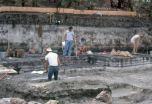Unsedated colonoscopy is common worldwide, but in the United States, conscious sedation is dominant and deep sedation is gaining support. Without sedation, the exam can cause discomfort due to the air pumped into the colon which causes the colon to stretch in order to more easily insert the colonoscope. Scheduled unsedated colonoscopy has been requested by seven percent of U.S. patients. In unsedated patients, discomfort during colonoscopy limits cecal intubation (colonoscope insertion reaching the cecum, which is the pouch that marks the beginning of the large intestine also known as the colon), which is essential for a complete exam. Methods for reducing discomfort have included several water-related techniques.
"A proof-of-principle, prospective, randomized, controlled trial demonstrating improved outcomes in scheduled unsedated colonoscopy by the water method"
Researchers at Veterans Affairs Healthcare System facilities in California developed a novel water method for scheduled unsedated colonoscopy using water infusion in lieu of air insufflation to more comfortably open the colon and insert the colonoscope. In their observational study of veterans, they showed that the novel water method enhanced cecal intubation and patient willingness to undergo a repeat scheduled unsedated colonoscopy. In this prospective, randomized controlled trial, the researchers' objective was to confirm these beneficial effects. From November 2007 to April 2009, eighty-two veterans underwent scheduled unsedated colonoscopy by either the air method (40 patients) or water method (42 patients). The main measurements were discomfort and procedure-related outcomes. The colonoscopies were performed by a single colonoscopist without registered nurse support.
The study confirmed that the water method significantly enhanced cecal intubation and patient willingness to undergo a repeat scheduled unsedated colonoscopy. The cecal intubation rate in the water group was 98 percent, significantly higher than that in the air group which was 78 percent. The percentage of patients reporting a willingness to repeat a scheduled unsedated colonoscopy was also significantly higher at 93 percent for the water group compared to 78 percent with the air group. The proportion of patients with at least one adenoma (precancerous polyp) showed a trend in favor of the water group at 36 percent, versus 23 percent in the air group. This trend was present for all indications in the proximal colon and for polyp size of 10 mm or larger. The cleansing effect of the water might have contributed to the higher adenoma detection yield. The adenoma detection rates were comparable to those in sedated colonoscopy.
Patients were blinded to the study method. To determine outcome measures for discomfort, a scale of zero (no discomfort) to 10 (most severe discomfort) was verbally communicated by the patients to an unblinded assistant during the colonoscopy and to a blinded observer five to 10 minutes after colonoscopy. The researchers reported that the decrease in maximum discomfort was significant and the decrease in overall discomfort approached significance with the water method. The method, but not patient charactersitics, was a predictor of discomfort.
The study acknowledges that the results from this Veterans Affairs trial cannot be generalized to other practice settings that rely primarily on sedation. Until demonstrated otherwise, the prolonged procedure time (56 minutes) is a distinct disincentive for the incorporation of scheduled unsedated colonoscopy into a busy endoscopy unit, even if discomfort is significantly reduced by the water method. The researchers concluded that evaluation of water method-assisted unsedated colonoscopy in diverse settings deserves to be supported.
"Warm water infusion versus air insufflation for unsedated colonoscopy: a randomized controlled trial"
A randomized controlled trial by researchers at Valduce Hosipital in Como, Italy, tested the hypothesis (proposed by observational studies by the Veterans Affairs Healthcare System researchers in California) that warm water infusion during the insertion phase of colonoscopy could increase the proportion of patients able to complete colonoscopy without sedation and could improve overall tolerance compared to the traditional procedure using air insufflation during unsedated colonoscopy.
Between April and July 2009, a total of 230 patients were randomly assigned to the water group (116 patients) or to the air group (114 patients). The main outcome measurements were the percentage of patients requiring sedation/analgesia, and pain and tolerance scores were assessed when the patients were discharged. Three endoscopists (two highly trained and one trainee) performed the procedures. The patients, but not the endoscopists, were blinded to the method. At regular intervals during the colonoscopy, patients were asked by the endoscopist and a gastrointestinal assistant about abdominal discomfort, pain and whether they wanted sedation/analgesia. After the procedure at discharge, an independent, blinded interviewer assessed patient pain, tolerance and willingness to repeat the procedure under the same circumstances.
The study found that the proportion of patients requesting sedation/analgesia during the procedure was 12.9 percent in the water group and 21.9 percent in the air group. Pain scores were 28 for the water group and 39 for the air group, based on a scale of zero (no pain) and 100 (worst pain ever). Tolerance was based on a similar scale and scores were 10 for the water group and 14 for the air group. At discharge, 90.5 percent of the patients in the water group said they would be willing to repeat the procedure under the same circumstances versus 81.6 percent of patients in the air group. Cecal intubation rates were 94 percent in the water group and 95.6 percent in the air group. The adenoma detection rates were 25 percent for the water group and 40.1 percent for the air group; a result that is in contrast to the Veterans Affairs study.
The researchers concluded that this randomized controlled trial shows that the use of warm water infusion instead of air insufflation during colonoscopy is associated with a decreased number of patients requiring on-demand sedation and significantly increases the overall tolerance of the procedure without compromising the success rate of cecal intubation. They do not believe that unsedated colonoscopy may replace sedated procedures; however, the technique might play a role in improving acceptance and tolerability of colonoscopy for patients willing or needing to undergo unsedated procedures. The lower adenoma detection rate associated with the water method, never reported before, is a matter of major concern and further evaluation is needed.
In an accompanying editorial about both studies, David H. Robbins, MD, MSc, Center for Advanced Therapeutic Endoscopy, Lenox Hill Hospital, New York, New York, states that, in regards to why there was a lower adenoma detection rate with the water method in the Italian study, "Because more polyps were detected and underwent polypectomy (polyp removal) in the air group, the perceived efficiency of air insufflation was mitigated and no overall procedure time difference was seen…While not significant, the VA study water cohort actually trended toward a higher ADR (adenoma detection rate). Having done a few hydroscopes (water method) myself and reviewing the world literature, I am prepared to go on record and call this particular finding an aberration…" Dr. Robbins adds that, "For patients who are at higher risk of, or fear, anesthesia-related complications, have no escort, want to interact with their physician during the examination, or need to get back to the trading floor that afternoon, there is little doubt that we have another option."
###
About the American Society for Gastrointestinal Endoscopy
Since its founding in 1941, the American Society for Gastrointestinal Endoscopy (ASGE) has been dedicated to advancing patient care and digestive health by promoting excellence in gastrointestinal endoscopy. ASGE, with more than 11,000 members worldwide, promotes the highest standards for endoscopic training and practice, fosters endoscopic research, recognizes distinguished contributions to endoscopy, and is the foremost resource for endoscopic education. Visit www.asge.org and www.screen4coloncancer.org for more information and to find a qualified doctor in your area.
About Endoscopy
Endoscopy is performed by specially-trained physicians called endoscopists using the most current technology to diagnose and treat diseases of the gastrointestinal tract. Using flexible, thin tubes called endoscopes, endoscopists are able to access the human digestive tract without incisions via natural orifices. Endoscopes are designed with high-intensity lighting and fitted with precision devices that allow viewing and treatment of the gastrointestinal system.
END



